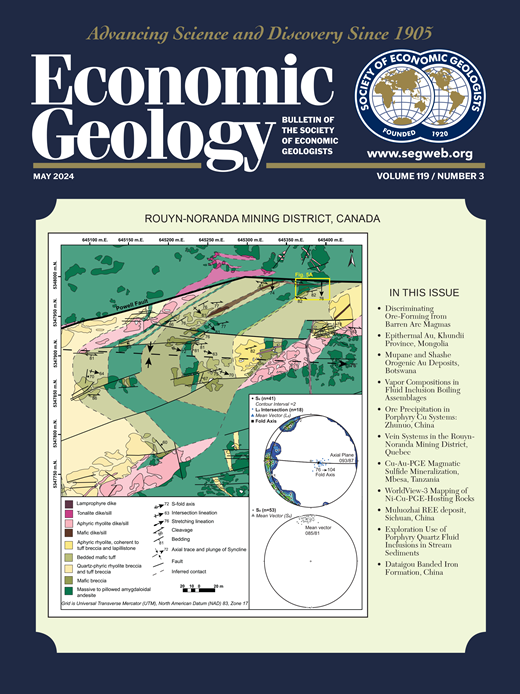Ultramafic-Hosted Ni-Cu-Co-(As) Mineralization from an Ancient Oceanic Transform Fault Zone in the Troodos Ophiolite, Cyprus: An Analogue for Ultramafic Sea Floor Massive Sulfide Mineralization?
IF 4.9
1区 地球科学
Q1 GEOCHEMISTRY & GEOPHYSICS
引用次数: 0
Abstract
Accumulations of sulfide minerals that are enriched in Ni-Cu-Co-(As) occur as sea floor massive sulfide (SMS) deposits associated with ultramafic rock types on the sea floor and in ophiolite terranes as Outokumpu-type mineralization. In this study we focus on similar mineralization at Lakxia tou Mavrou in the Limassol Forest Complex of Cyprus, which represents the on-land exposure of an oceanic transform fault zone preserved within the Troodos ophiolite. Mineralization here consists of massive lenses of pyrrhotite associated with veins of isocubanite, chalcopyrite, Co pentlandite, and chrome spinel hosted in serpentinized mantle peridotite. We reexamine the field context of mineral occurrences and use in situ mineral chemistry, element mapping, and sulfur isotope ratios (δ34S) to constrain metal sources and provide an updated paragenetic model for Lakxia tou Mavrou. Highly variable S/Se ratios (304–108,571), a depletion in platinum group elements relative to mantle values, and an average δ34S value of –3.7 ± 2.4‰ (1σ, n = 17) in sulfide minerals support a hybrid hydrothermal and magmatic origin for the mineralization. Metals at Lakxia tou Mavrou were sourced from both the serpentinization of peridotites and from crosscutting intrusions, with later intrusions into the already serpentinized mantle lithosphere host providing a heat source to drive prolonged hydrothermal circulation. The reexamination of the field context of mineralization shows that the Ni-Cu-Co-(As) mineralization at Lakxia tou Mavrou originally formed because of the fault-guided intrusion of hot primitive magma bodies into serpentinized shallow mantle lithosphere in the active domain of an ocean-floor transform fault zone. The mineralization was subsequently partially disrupted by structures related to emplacement of the Troodos ophiolite. We show that the relationship between serpentinization, magmatism, and hydrothermal circulation at Lakxia tou Mavrou can be used to understand the formation of ultramafic-hosted SMS deposits in transform fault and other ultramaficdominated slow- and ultraslow-spreading mid-ocean ridge settings.塞浦路斯Troodos蛇绿岩古大洋转换断裂带的超镁铁质Ni-Cu-Co-(As)成矿作用:与超镁铁质海底块状硫化物成矿作用类似?
富含Ni-Cu-Co-(As)的硫化物矿物以海底块状硫化物(SMS)矿床的形式聚集,与海底超基性岩石类型和蛇绿岩地体中的奥托昆普型矿化有关。在这项研究中,我们将重点放在塞浦路斯利马索尔森林复合体的Lakxia toumavrou的类似矿化上,这代表了Troodos蛇绿岩中保存的海洋转换断裂带的陆地暴露。这里的矿化由磁黄铁矿的块状透镜体组成,与等长石、黄铜矿、钴镍长石和铬尖晶石等矿脉伴生在蛇纹化的地幔橄榄岩中。我们重新研究了矿物赋存的野外背景,并利用原位矿物化学、元素填图和硫同位素比值(δ34S)来限制金属来源,并提供了一个更新的拉克夏头马弗鲁共生模型。S/Se比值变化较大(304 ~ 108,571),铂族元素相对于地幔值明显减少,硫化物矿物的平均δ34S值为-3.7±2.4‰(1σ, n = 17),表明成矿为热液-岩浆混合成因。拉克夏头马夫鲁地区的金属既来源于橄榄岩的蛇纹岩化,也来源于横切侵入物,侵入物进入已经蛇纹岩化的地幔岩石圈主体提供了热源,推动了长时间的热液循环。对成矿背景的重新考察表明,拉克夏头马弗鲁的Ni-Cu-Co-(As)成矿最初是由于热原始岩浆体在断裂引导下侵入海底转换断裂带活动区内蛇纹岩化的浅层地幔岩石圈而形成的。成矿作用随后被与Troodos蛇绿岩侵位有关的构造部分破坏。研究表明,拉克夏-马夫鲁地区蛇纹岩化作用、岩浆作用和热液循环之间的关系可用于理解转换断层和其他超镁铁质为主的慢扩张和超低扩张洋中脊环境下超镁铁质为主的SMS矿床的形成。
本文章由计算机程序翻译,如有差异,请以英文原文为准。
求助全文
约1分钟内获得全文
求助全文
来源期刊

Economic Geology
地学-地球化学与地球物理
CiteScore
10.00
自引率
6.90%
发文量
120
审稿时长
6 months
期刊介绍:
The journal, now published semi-quarterly, was first published in 1905 by the Economic Geology Publishing Company (PUBCO), a not-for-profit company established for the purpose of publishing a periodical devoted to economic geology. On the founding of SEG in 1920, a cooperative arrangement between PUBCO and SEG made the journal the official organ of the Society, and PUBCO agreed to carry the Society''s name on the front cover under the heading "Bulletin of the Society of Economic Geologists". PUBCO and SEG continued to operate as cooperating but separate entities until 2001, when the Board of Directors of PUBCO and the Council of SEG, by unanimous consent, approved a formal agreement of merger. The former activities of the PUBCO Board of Directors are now carried out by a Publications Board, a new self-governing unit within SEG.
 求助内容:
求助内容: 应助结果提醒方式:
应助结果提醒方式:


